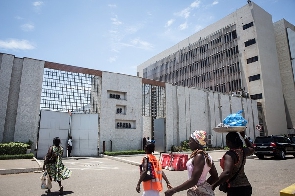The surprisingly deep 150 basis point cut in the benchmark Monetary Policy Rate by the Bank of Ghana – from 16 percent to 14.50 percent -has successfully instigated a drop in lending rates but they have not fallen quite as deeply.
Importantly however, commercial banks have, on average more or less retained the deposit rates they offered prior to BoG’s February MPR cut meaning they have accepted a narrowing of their interest margins.
According to data from the central bank, the Ghana Reference Rate, which it computes in conjunction with the commercial banks themselves and which serves as their base lending rate, fell by 106 basis points from 16.18 percent in February to 15.12 percent in April.
But the average lending rate, which includes the risk premiums added on by banks on each loan and (the annualized) fixed fees on loan agreements, declined by a marginally slower 99 basis points, from 23.37 percent in February to 22.38 percent by April.
This is attributed mainly to the fact that the fixed fee component of total loan costs is not reduced along with coupon interest rates.
Importantly though, the interbank weighted average rate fell even faster than the MPR itself, from 15.86 percent in February to 13.98 percent by April.
This indicates an improvement in banks liquidity, following the monetary stimulus announced by the BoG in February which reduced both their reserve requirements and their capital buffer, the latter effectively reducing the required minimum capital adequacy ratio from 13 percent to 11.50 percent.
This means banks have more money to lend, although this does not automatically translate into more lending. The structure of interest rates currently still enables banks to comfortably make profits from investing their deposits in government securities – whose issuance has risen in response to significantly higher cedi-denominated fiscal deficit needs of government due to the coronavirus outbreak – rather than lending to customers in the current virus-instigated uncertainty in the business operating environment.
Since the key rate cut in February, the average rate offered by banks on savings accounts has remained unchanged at 7.58 percent while that on current accounts has remained stable at 2.80 percent on average.
Similarly the average offered rate on three month fixed deposits has remained unchanged at 11.50 percent. However the average offered rate on six month fixed deposits has fallen by 100 basis points from 11.50 percent as at February to 10.50 percent by April.
Meanwhile every type of government domestic debt security offers coupon yields of over 14 percent. Even though the 91day treasury bill has fallen by 66 basis points since February, by the end of April it was still offering 14.05 percent.
Similarly 182 day bills were offering 14.27 percent by April, albeit down from 15.17 percent; and 364 day bills were offering 16.76 percent, down from 17.81 percent.
Two year treasury notes were offering 19.00 percent by April, unchanged since the beginning of this year, while three year bonds were offering 19 percent, down from 20.75 percent in February.
Conversely, five year bond yields were offering 21.70 percent, up 220 basis points from the 19.50 percent they were yielding as at February.
While banks have the potential to earn wider interest margins on loans to customers than on investment in government treasury instruments the difference is narrow enough for banks to opt for the lower yielding, but risk free latter.
However BoG, well aware of this, says it will monitor how the increased liquidity made available to banks by the monetary stimulus is being used, to ensure that it goes into support for enterprise.
Click to view details



Business News of Monday, 25 May 2020
Source: goldstreetbusiness.com

















